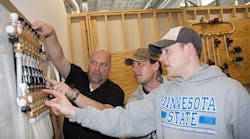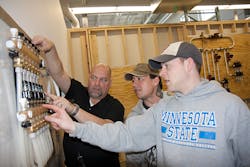Latest from Best Practices
Sponsored
Training for new technologies in mechanical industry — Part 2
If you did not read the first part of this article by Steve Swanson, click the Related Media link to access Part 1 of this informative article about utilizing different learning styles.
After understanding the different learning styles, you can incorporate them into a learning environment that is conducive to all the styles. The National Research Council was commissioned to produce a study of how people learn in a holistic environment. If you are interested in learning more about this, look for the book “How People Learn — Brain, Mind, Experience and School” on the Internet.
The “Knowledge of How People Learn” graphic was taken from that book as an example of how your company can produce a training culture versus a training plan. The benefit of this graphic is that it shows that rather than having one or two big trainings a year that may or may not use all of the learning styles, a map of how you might bring a small amount of learning into each week is more effective. A slow, steady buffet of learning stays with you much more effectively than gorging on a learning banquet.Now let’s look at a few examples of different learning activities that you can import into your company to incorporate new technologies.
One simple and easy way to spread the learning around is to take this magazine and highlight the articles that are specific to your company’s needs. There are digital versions of Contractor Magazine that can be found here at this website. You can send links of particular articles to your staff that they can go through on their own time. Make sure you’re getting back to them to see if they have completed the reading. Quizzing them from time to time gives a positive reinforcement towards learning.
Speaking of using technology to train, many manufacturers have space on YouTube with all kinds of short training videos on how to use their products. These are invaluable for installations and troubleshooting issues. Find some that are useful to you and send your employees links to these with the expectation that they see them. Or host a Friday lunch to go through a few of these short trainings together.
Suppose that one of your techs has an issue with a new control system. You can usually go on that manufacturer’s YouTube channel and watch a video of how to do the installation. Get the techs together and go through this together along with the handout of the installation instructions for the visual learners in your group.
If you also have an example of the piece of equipment on hand for the tactile learners, you now have a training that is relevant, timely and touches the different learning styles. This small investment of time and resources will multiply the skill level for the whole team and pay you back for years to come.
Lunch and learns: Many manufacturers offer “lunch and learns” for their customers to introduce new products. They are one-hour trainings offered over the lunch hour, so the employees are not experiencing as much down time in the field. You can often ask your manufacturer reps to provide training on a specific product or installation practice that is currently needed.
Votech schools: Evening classes at votech schools are a great way to raise the skill level of employees. You get immediate benefits of skill growth, and employees get the benefit of becoming more qualified in the industry. One contractor I know offers to pay for employees’ training in exchange for a one-year employment contract.
Manufacturer training: Sending technicians to factories for training is an excellent way to raise skill level. Most good manufacturers’ trainers are already aware of the different styles of learning skills and are good presenters who really do impart skills to your staff. Good manufacturer training is done without an overt sales pitch. A small amount of it will be there by necessity, but it is not the focus and, if it is done right, it is not even noticeable.
Fears about training
“Past trainings were boring and all that your employees got was a four-hour sales pitch.” Alas, there are some poor trainers out there as well. Sometimes companies will take someone who is great at installing something and expect them to become a trainer. Before going to a training, ask the people hosting the training if it is genuine training or a four-hour sales pitch. Just asking the question often changes how the class is going to go, so don’t be afraid to ask — you’re the customer. And don’t be afraid to let them know if the training was too much selling and not enough learning. They are motivated by you and your remarks.
“I fear poaching of freshly trained, skilled staff.” The thinking is, “It’s easier to steal an already skilled tech than it is to train them yourself.” First of all, this is not a sustainable solution for the industry. Secondly, it is not good for the employee in the long run. Companies that poach don’t train — that’s why they poach. So you may initially receive a bit more money, but you will soon stagnate in your skills and become less valuable in the long run. It is consistently shown that companies who do invest in training, over the long run, produce technicians who are more skilled than the poachers who bounce from job to job.
I’ve known contractors who poach regularly. They have the lowest morale, greatest fear of job loss and the worst sense of team-building in the industry. The greatest deterrent of poaching is a slow, long process of training that produces a team and a good working environment with job stability. Check the statistics yourself and you will see.
“Training takes time away from making money.” This is a short-sighted fear, I’m afraid. Statistically, trained and skilled technicians produce more revenue than their training has cost them.
“Training just to have training often leads to skills not used in your own environment.” On this one I actually agree. Training needs to be relevant, timely and based on your needs. Anything else is not training. It is knowledge. Knowledge doesn’t get you any further upstream.
To wrap this up, remember this, training for technology is a little like rowing upstream. As soon as you stop, you are going backwards.
I would be grateful to hear your thoughts, ideas and stories. You can reach me at [email protected].
Until then, best regards and happy heating.
Steve Swanson is the customer trainer at Uponor Academy. He can be reached at [email protected].




